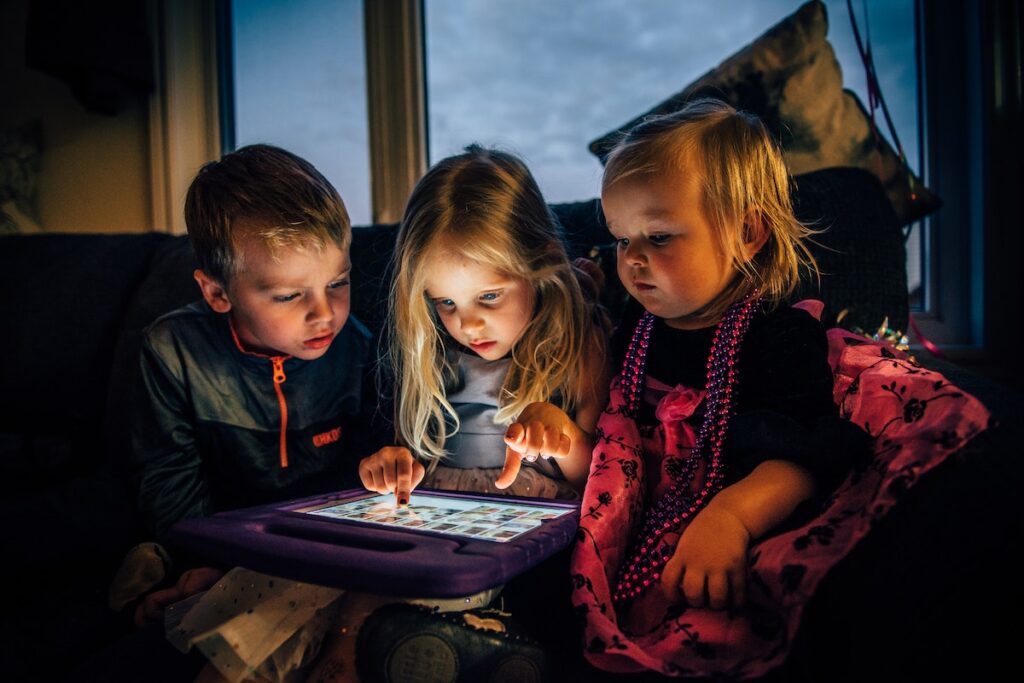Parents wonder about the effects of screen time for kids on their education. The ever-increasing presence of screens in our daily lives has drawn attention to its possible negative impacts – especially regarding excessive screen time on our children’s well-being and education.
Thus, learning to set responsible limits around technology is imperative for caregivers & educators alike. To help combat this issue, this blog post explores how ample screen time affects your child.
Understanding Screen Time For Kids
Screen time for kids signifies any length spent using numerous technological gadgets: laptops/desktops; smartphones; gaming consoles; television sets; etc. Methods contributing to excess include online learning/ browsing social media feeds and video viewing/gaming antics.
In modern society, parents need to identify children’s access to numerous ubiquitous devices contributing to excessive screen time, such as:
- tablets/smartphones for communication/internet browsing,
- laptops for academic purposes/ video streaming,
- television sets and
- gaming consoles for entertainment.
So, what are the current recommendations and guidelines for screen time limits? Screen limit experts from various organizations have guided the daily screen time for kids.
Certainly, those between the ages of 2-5 should only spend an hour of high-quality screen time. At the same time, older kids’ schedules must ensure reasonable limitations without interrupting their overall learning experience and nocturnal slumber.
Effects of Excessive Screen Time on Education
Excessively watching screens is known for being problematic in education since it negatively influences children’s learning experience. Therefore implementing practical solutions for a child under this issue is vital.
- It affects Cognitive Development and Academic Performance.
Excessive screen time can interfere with memory retention and information processing, causing reduced academic achievement since extended exposure limits kids’ ability to concentrate, affecting critical thinking skills.
- It Affects Their Health and Well-being
Unquestionably having your child spend countless hours on screen sitting down would undoubtedly result in negative physical consequences such as obesity while limiting other activities related to emotional well-being.
They dwell more on screens than outdoor activities, which can cause mental health complications such as stress, anxiety, or depression, affecting their social and emotional development.
- It Affects attention span and concentration
Prolonged screen exposure has been demonstrated to impact children’s attention span and concentration abilities negatively. The unending stimuli from fast-paced digital content pose a challenge for young learners attempting activities requiring an extended focus period, including homework assignments or studying.
- It Causes disruptions to sleep patterns and overall well-being
Parents should be in the know of the potential harm from excessive electronic exposure, especially before bed, since blue light can cause problems with natural hormonal regulation, which affects sleep cycles leading to negative impacts on well-being overall; both physical health, as well as educational abilities, might suffer consequences from not getting enough rest at night.

- It Potentially Impacts Social and Emotional Skills
Spending too much time on screens interferes with developing critical social-emotional faculties fundamental to structuring positive engagement in the outside world. This could be detrimental due to limited opportunities for building empathy, effective communication, and establishing meaningful connections with others. These skills are necessary for navigating many social situations and acquiring essential emotional intelligence.
Finding the Right Balance
Aiming for equilibrium is critical to lessening the detrimental effects of screen time. Implementing limits varying according to age and endorsing diverse offline activities are essential to achieve this.
- Setting Age-Appropriate Screen Time Limits
In managing child screen usage, adequately protecting each age range must guide approval levels. It’s essential – especially with young children – to recognize their unique developmental stage and limit their screen time accordingly while offering guidance in appropriate periods when they get older.
- Prioritizing Offline Activities and Face-to-Face Interactions
Offline Activity engagement is vital to fostering all-around personal development momentum- sports participation seeing books read the old-fashioned way, or indulging in hobbies- encourages independence from device usage, which impacts everyday life experiences like family/friend interactions.
- Mindful Screen Time Practices
It is crucial to promote mindfulness among children when accessing screentime-focused media sources. Encouraging an active approach towards screen time through educational apps, interactive games, or online learning platforms can enhance cognitive processes such as critical thinking, problem-solving skills, and creativity.
Moreover, teaching young individuals the importance of quality assessments when consuming media content will inspire curiosity while increasing media literacy skills.
- Active Lifestyle Balance with Screen Time
An impetus for attention must exist toward promoting an active lifestyle balance in children by encouraging physical activities in outdoor play settings and moderate screen time usage. Moderate physical activity routines involving running around grassy fields or playing age-appropriate ball games can help improve motor skills while developing muscle toning exercises within the child’s growth phase, leading to a healthy lifestyle pattern over time.
Lastly, unstructured outdoor playtime fosters imagination-building activities encouraging the social development of friendship bonds and helping kids grow up healthy mentally as well as physically sound.
Promoting Healthy Media Habits
The amount of time our kids spend using electronic devices can have an impact on their health, both physically and mentally. Encouraging active participation in decision-making about appropriate screen limits helps parents and guardians promote responsible behavior while fostering healthy tech habits in children.
Guiding kids towards healthy media habits is a shared responsibility among parents/caregivers.
- Monitoring and Supervising Screen Time Activities: It demands participation and active engagement with kids’ screen time habits to ensure they engage appropriately in safe content suitable for their age.
- Engaging in Co-viewing and Co-learning Experiences: Engaging as parents/caregivers alongside your kids when consuming diverse types of globally available digital programs provides valuable co-learning experiences for you and your child/children.
- This way, parents leverage opportunities to guide the children toward understanding how best to interact safely with gaming capabilities within various apps/websites/social networks/etc.
- Evaluating and Selecting High-Quality Educational Content: Parents carefully evaluate available options and then choose top-quality educational content aligning with their child’s interests & academic/skills development journey – this ensures that screen time transforms into an experience that offers tremendous value via learning opportunities presented by such sources crafted just for them.
- Encouraging Alternative Activities/ Encouraging Critical Thinking and Media Literacy Skills: It is essential to encourage children through alternative activities such as crafts projects and reading board games puzzles while fostering creativity and developing critical thinking skill sets beyond the digital space; leading by example encourages proactive offline engagement that ultimately shapes healthier digital consumption behaviors.
- Leading by Example: Parents are significant contributors in molding their children’s conduct. Setting an example of having sensible screen time habits helps to create a more favorable atmosphere that instills balance importance into our families’ values. Prioritizing face-to-face communication over device-dependent interactions encourages offline activities that provide holistic growth opportunities for our children.
- Teaching by example includes introducing children early on to core digital literacy skills empowering them throughout life to know how vital it is to analyze critically any information encountered online effectively.
- Creating a Family Media Plan: It’s highly recommended that you create a family media plan outlining clear daily activities guidelines. To ensure these are followed through, it might help if every member had input while developing such policies. Working together to establish these rules gives children the reins over their digital habits.
- Establishing Clear Guidelines / Setting Clear Expectations and Boundaries: Laying down practical boundaries about where screens will be used (study or bedroom), when they are allowed, and how long – support setting boundaries which will give them structure and consistency.
- Implementing Screen-Free Zones and Times: Encouraging electronics-free zones at certain times, such as mealtimes, will promote superb communication among family members.
Supporting Offline Learning and Creativity

Providing children with ample opportunities related to offline learning enhances their educational experience leading to holistic development, thus fostering creativity among them.
- Encouraging Reading and Providing Access to Books
Reading caters to boost literacy, giving kids better scope for acquiring knowledge as it expands their intellect horizontally (by opening new facets), paving the way towards lifelong learning.
They should get exposure from various genres, which would build upon developing multiple perspectives, positively impacting the imagination levels of kids over time. Facilitating access at home furnishing age-appropriate books coupled with additional visits regularly push their reading habits even further.
- Engaging in Hands-on Activities, Hobbies, and Creative Play
Taking part in hands-on activities provides ample room for exploration through hobbies and creativity-boosted imaginative levels leading to problem-solving skills intrinsically.
Children can be encouraged to explore their interests by indulging in activities like painting, building, and playing musical instruments, thereby getting self-expression and personal growth.
- Fostering Curiosity and Exploration Beyond Screens
Parents can expose kids beyond screens to evoke curiosity—visiting museums, scientific centers, and other educational locales that enable better insight fostering a sense of exploration within them.
Children should also be encouraged to actively seek answers to their questions, making it a way to engage with the world and people around them and igniting lifelong learning.
- Promoting Outdoor and Nature-Based Learning Experiences
Nature-based activities such as gardening or outdoor exploration during nature walks have multifaceted benefits as they promote children’s physical activity followed by observation skills fostering environmental awareness.
It becomes a way to encourage overall personality development while instilling in kids an appreciation for nature, leading toward more significant impacts in terms of environmental stewardship.
Conclusion
In this present age where screens dominate every aspect of life, being mindful of their impact on academics has become imperative. Excessive screen time negatively affects cognitive development, leading to poor school performance and risks to physical health. To prevent these effects from taking root in our homes, Establishing specific rules which limit online engagement while boosting stimulus for offline learning provides the safe space necessary for our kids’ achievement.












